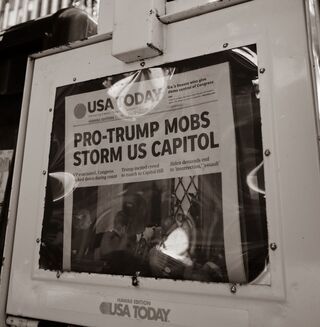Politics
How Will Historians Interpret the Storming of the Capitol?
How current and future historians will make sense of the insurrection.
Posted January 24, 2021

After the attack on the Capitol, an ex-student who now teaches high school contacted me. He queried, “Students ask what history will say about what happened yesterday. I am not sure how to respond. I was hoping you could share your thoughts. Obviously, nothing like what happened yesterday has ever happened before. What will history and historians say?”
My initial thought was that January 6 resembled the Night of Broken Glass that occurred on November 8, 1939 in Germany. Jewish businesses were destroyed, Nazi thugs attacked Jews throughout Germany, synagogues were burned, and dozens were killed. Arnold Schwarzenegger cited the incident in his address based on the “broken glass” and smashing of windows in the Capitol. Also, historians consider the Night of the Broken Glass the first act of the Holocaust since it was the first mass action throughout Germany against the Jews, much as the D.C. protest epitomized on a dramatic national stage many smaller, prior counterprotests against liberal activism throughout the U.S. But the pogrom was clearly orchestrated by Joseph Goebbels, while it is still not clear how “planned” the D.C. attack was. Thus, like most attempts to find precedence in Holocaust events, the comparison rarely elucidates.
Other historians have looked at history to find an analogy for January 6. James Mcauley in The Atlantic wrote, “France Knows How this Ends,” arguing that the Dreyfus affair of the late 19th century is a precursor to now-fractured U.S. politics. Dreyfus was a French military attaché wrongly accused of treason. France’s rule of law and individual rights ultimately prevailed to clear Dreyfus’s name, but the numerous trials consumed a decade, Dreyfus was broken by the experience, and the political fallout fractured the Third Republic. Arguably, France did not succumb to the numerous internal fascist movements of the 1930s because democracy was instilled into France’s political culture by the Dreyfus affair. Perhaps January 6 will deepen our commitment to the republic.
In The New York Review of Books, Mark Danner describes his experience as an observer amongst the participants of the January 6th coup attempt. Danner’s “Be Ready to Fight” warns Trumpism will not disappear from the stage and his analogy is to Mussolini’s March on Rome and Hitler’s Beer Hall putsch, although he frames his actual experience as observing participant in light of Caesar’s Crossing the Rubicon to overthrow the Roman republic.
Both articles are excellent reads. They led me to consider other historical analogies that might illuminate the event.
I thought about the French Revolution. In explaining how France’s masses were radicalized to revolt, historians often refer to weakness at the top, highlighting Louis XVI’s failure to take decisive action, and Marie Antoinette’s loathsome reputation among the common people. This weakness interacted at key moments with a radicalization from below.
The first time the mob took the revolution into their own hands was with the storming of the Bastille, the ancient citadel in Paris that symbolized the old regime. Not surprisingly, Bastille Day—July 14th—was chosen late in the 19th century as the day to commemorate the revolution. However, many historians recognize the October days of 1789, when Parisian market women marched on Versailles, as the most important turning point of the revolution. In my opinion, the marches on Versailles provide the best analogy for January 6th.
In the early fall of 1789, the French were starving and in dire straits. Rumors circulated that the victories of Bastille Day—namely the acceptance of the Declaration of Rights of Man and Citizen, along with decrees from the king abolishing feudalism—were being overturned or rolled back. Roughly 6,000 resilient market women gathered in Paris. After storming the Hotel de Ville (City Hall) for food and munitions, they decided to march 16 miles southwest to Versailles to take their petitions directly to the king. Similar to January 6th, the mob had a variety of ideological motivations. All were disgusted by the opulence of Versailles amidst the starving population; some hoped the king (le bon papa) would appease their needs. Others wanted the king’s royal guards removed and replaced with national guardsmen sympathetic to their causes. Ultimately, they wanted the king removed from Versailles and brought to Paris to secure the revolution. At this point, most revolutionaries were aspiring for a Constitutional monarch, although some in the crowd were calling for the queen’s death.
As the crowd arrived at Versailles, six of its leaders were given an audience with the king. He ordered that the crowd be given food. This pacified many of the women, but others remained, causing a ruckus. At the urging of Marquis de Lafayette, who sympathized with the king, the king accepted the Declaration of the Rights of Man and the decrees abolishing feudalism. Nevertheless, the women spent the night outside, and early the next morning they found an unguarded gate and stormed the palace. The royal guard tried to blockade them and even shot one of the women. The women pushed on and killed, and then beheaded, one of the royal guards as they searched frantically for the queen’s bedchamber. She was able to escape at the last moment into the king’s quarters. Eventually Lafayette, whose national guard sided with the people, intervened, quelled the crowd, and persuaded the king to return to Paris with the women. The king and queen became prisoners of the revolution and were brought back to Paris as gunshots rang out overhead and their carriage was surrounded by women, two of whom were carrying the heads of the guards on pikes. The aura of royal power as invincible was no longer tenable.
In similar fashion, the breach of the Capitol leaves all Americans to ponder the reality that millions of our brethren no longer hold our institutions sacred.
Trumpism combines the proposition of aggression and the will to power with anti-elite white grievance and victimization. This combination motivated the festooned rioters at the Capitol. Rambo flags waved proudly at the riot. This was not about weakness at the top, as was the case with the French Revolution, but rather chaos inspired from the top against the establishment itself. Trump procrastinated for over six hours before some Lafayette was able to convince him to call the insurrection off. As the rioters shouted “Hang Mike Pence! Hang Mike Pence!” with a makeshift gallows ready for use, Pence played the role of Marie Antoinette—barely escaping death. January 6th was the culmination of Trump’s pathological, feverish politics, which started with his 2016 ride down the escalator of Trump Tower to announce his candidacy.
After Louis XVI was brought to Paris, the French Revolution settled into an uneasy truce until June 1791, when the king and queen attempted to flee to Austria to muster troops to overturn the revolution. For the revolutionaries, this was a clear act of treason. In a similar fashion, Trump’s attempt to overturn the election and “Stop the Steal” has led to his second impeachment against him. Trump is very aware that the trial will cause “tremendous anger amongst his supporters.”
No doubt the state will summon its powers to stop the violent extremists. But what about the millions of trumpeters? What will Trump do next with this angry mob that no longer believes in the legitimacy of our democracy and institutions?
I remain fearful for our republic. For years I have vehemently disagreed with “leftist” professors who preach that the CIA controls the world, and the neo-Marxists who argue that our democracy is just a shill for America’s global capitalist domination, no different than other authoritarian regimes. To this conspiratorial thinking on the left we can now add the right’s concoction of “deep state” sham elections, fake news, etc.
I often play for students, before lecturing on fascism, Joni Mitchell’s “Slouching Towards Bethlehem,” which quotes or paraphrases nearly all of Yeats’ 1919 poem "The Second Coming." The collaborative work conveys the fragility of democracy. In my opinion, Yeats’ fears remain ours now:
“Things fall apart; the centre cannot hold;
Mere anarchy is loosed upon the world,
The blood-dimmed tide is loosed, and everywhere
The ceremony of innocence is drowned;
The best lack all conviction, while the worst
Are full of passionate intensity.”




